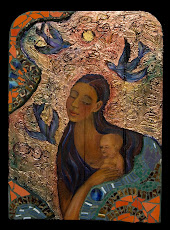So what does this topic have to do with the creative life? More than you might think at first glance. Creativity and our willingness to embrace positive change are integral to changing the course of planetary environmental degradation. I got started thinking about this while drawing the chili peppe
 r plant growing in my house. Though it's officially spring in Bend, Oregon, it is in the 20's and snowing today. Growing in the sunshine of our upstairs window, this perennial plant is an abundance of bright green leaves teamed with a few dozen slender, brilliantly red & green, small chili peppers.
r plant growing in my house. Though it's officially spring in Bend, Oregon, it is in the 20's and snowing today. Growing in the sunshine of our upstairs window, this perennial plant is an abundance of bright green leaves teamed with a few dozen slender, brilliantly red & green, small chili peppers.I let the chilies ripen red and dry on the vine, then I crumble them over salted, roasted peanuts for an afternoon snack. Sometimes I put them in a salsa or red chili sauce. The unique thing about this chili plant is that it is native to New Mexico, the home of my paternal grandmother's ancestors. I like eating a food that enriched the lives of my ancestors for generations. You can buy seeds for this and other native plants at Native Seeds/SEARCH. Native Seeds/SEARCH is a non-profit that is striving to preserve the genetic diversity of our country's South West heirloom and indigenous food and utility crops. No matter how "organic" our food is, if we continue to lose biodiv
 ersity, our food supply can be easily jeopardized by diseases or other unforeseen problems.
ersity, our food supply can be easily jeopardized by diseases or other unforeseen problems.Native Seeds/SEARCH describes themselves thus: "The Native Seeds/Search Seedbank houses, for future generations, the seeds of crops and wild plants traditionally used as food, fiber and dyes by prehistoric and more recent cultures inhabiting the arid southwestern U.S. and northwestern Mexico. . . approximately 2,000 different accessions of traditional crops grown by Apache, Chemehuevi, Cocopah, Gila River Pima, Guarijio, Havasupai, Hopi, Maricopa, Mayo, Mojave, Mountain Pima, Navajo, Paiute, Puebloan, Tarahumara, Tohono O'odham and Yaqui farmers. Over one-half of the collections are comprised of the three sisters -- corn, bean, and squash. An additional 48 species of crops and wild crop relatives wait in frozen storage, including amaranth, tepary bean, chile, cotton, devil's claw, gourds, melon, sunflowers, tobacco, teosinte, watermelon and wild beans."
The "Three Sisters" of corn, beans and squash are the crops that the American Indians considered necessary to support a settlement. Honoring these indigenous crops and that American Indian heritage along with the Spanish heritage of the American Southwest, I painted a Santos style retablo of my Madonna, Guadalupe with the Three Sisters: Corn, Squash & Beans.This retablo is part of my Hispanic Culture Sacred images series.
If you live anywhere in the American Southwest, or if like me, you have a sunny window, I encourage you to look through the www.nativeseeds.org website. They sell heirloom seeds, baking mixes, spices, art, goat milk soap, even Christmas ornaments by Hopi artist Gerald Dawavendewa and others. Another thing they do that is so generous both individually and to our planet is their Native American Outreach program where they give a certain amount of seeds to American Indians for their gardens, along with Adopt A Crop program to keep those seeds viable. They also have a Cultural Memory Bank Project that pairs the knowledge of the geneticist with the folklorist to conserve not only the plant, but how that plant was nurtured and utilized. Art and Science together for the good of our planet. Now that's creativity!

















No comments:
Post a Comment